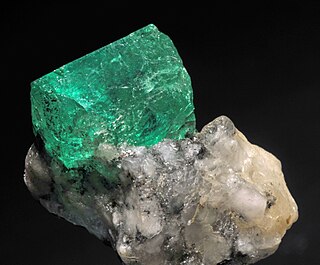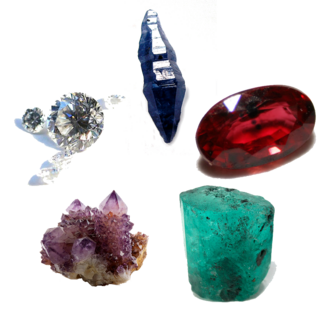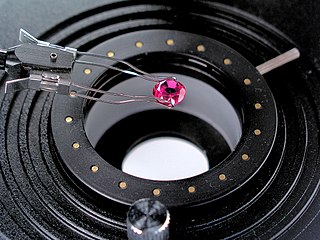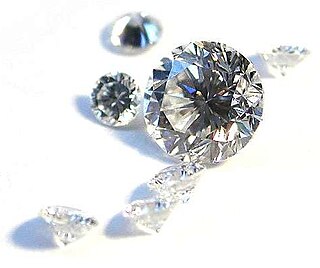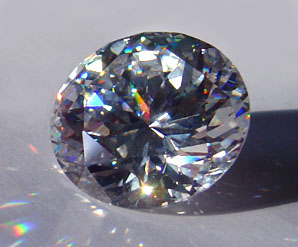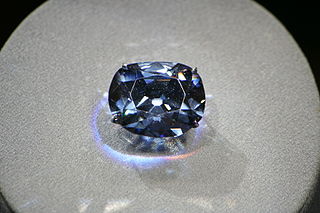Clarity enhancements
The clarity, or purity, of a diamond refers to internal inclusions of the diamond, and is one of the 4-Cs in determining a diamond's value. Common inclusions that appear inside diamonds are black carbon spots and small cracks, commonly referred to as fractures or "feathers", due to their feathery whitish appearance when viewed from above or through the side. Diamonds may also have other inclusions such as air bubbles and mineral deposits, such as iron or garnet. The size, color, and position of the inclusions are factors in determining the value of a diamond, especially when the other gemological characteristics are of a higher standard.
Laser drilling
The development of laser drilling techniques has increased the ability to selectively target, remove and significantly reduce the visibility of black carbon inclusions on a microscopic scale. Diamonds containing hematite inclusions have been laser-drilled since the late 1960s, a technique credited to Louis Perlman that did a successful test a year after General Electric had made a similar one with a diamond for industrial use in 1962. [1]
The laser drilling process involves the use of an infrared laser (of surgical grade at a wavelength about 1064 nm) to bore very fine holes (around 0.02 millimeters in diameter) into a diamond to create a route of access to a black carbon crystal inclusion. Because diamond is transparent to the wavelength of the laser beam, a coating of amorphous carbon or other energy-absorbent substance is applied to the surface of the diamond to initiate the drilling process. The laser then burns a narrow tube or channel to the inclusion. Once the location of included black carbon crystal has been reached by the drill channel, the diamond is soaked in sulfuric acid. After soaking in sulfuric acid the black carbon crystal will dissolve and become transparent (colorless) and sometimes slightly whitish opaque. Under microscopic inspection the fine drill or bore holes can be seen, but are not distracting and do not affect sparkle or brilliance of the diamond. While the channels are usually straight in direction, from an entry point on the surface, some drilling techniques are drilled from within, using naturally occurring fractures inside the stone to reach the inclusion in a way that mimics organic "feathers". (This method is sometimes referred to as KM drilling which stands for special drilling in Hebrew.) [2] The channels are microscopic so that dirt or debris cannot travel down the channel. The surface-reaching holes can only be seen by reflecting light off of the surface of the diamond during microscopic viewing such as a jeweler's 10x magnifying lens or loupe and are invisible to the naked eye.
Fracture filling
This section needs additional citations for verification .(April 2016) |
While fracture filling as a method to enhance gems has been found in gems over 2,500 years old, [3] the diamond's unique refractive index required a more advanced filler than simple wax and oil treatments. This technology became available roughly 20 years after the time the laser drilling technique was developed. Simply put, "fracture filling" makes tiny natural fractures inside diamonds less visible to the naked eye or even under magnification.
Fractures are very common inside diamonds and are created during the diamond's creation in the Earth's crust. As the rough diamond travels up from the Earth's crust through volcanic pipes it comes under extreme stresses and pressures, and during this travel tiny fractures can form inside the diamond. If these fractures are visible and damaging to the beauty of the diamond, it will have much lower demand and will not be as salable to jewelers and the general public, making them candidates for fracture filling and thus visually improve the appearance of the diamond.
The fracture filling of diamond is often the last step in the process of diamond enhancement, following laser drilling and acid-etching of inclusions, though if the fractures are surface-reaching, no drilling may be required. The process involves the use of specially-formulated fillers with a refractive index approximating that of diamond. It was pioneered by Zvi Yehuda of Ramat Gan, Israel, and Yehuda is now used as a brand name applied to diamonds treated in this manner. Koss & Schechter, another Israeli firm, attempted to modify Yehuda's process in the 1990s by using halogen-based glasses, but this was unsuccessful. The details behind the Yehuda process have been kept secret, but the filler used is reported to be lead oxychloride glass, which has a fairly low melting point. The New York-based Dialase also treats diamonds via a Yehuda-based process, which is believed to use lead-bismuth oxychloride glass, but research into creating better, more durable, less traceable fillers is still being done, creating more silicone-based fillers for the fracture filling process.
The filler present in fracture-filled diamonds can usually be detected by a trained gemologist under the microscope: While each diamond gets a treatment that fits its unique shape, state and fracture status, there may be traces of surface-reaching bore holes and fractures associated with drilled diamonds, air bubbles and flow lines within the glass, which are features never seen in untreated diamond.
More dramatic is the so-called "flash effect", which refers to the bright flashes of color seen when a fracture-filled diamond is rotated; the color of these flashes ranges from an electric blue or purple to an orange or yellow, depending on lighting conditions (light field and dark field, respectively). The flashes are best seen with the field of view nearly parallel to the filled fracture's plane (although specific fractures in untreated diamonds may cause similar "flash effect"). [3] In strongly colored diamonds the flash effect may be missed if examination is less than thorough, as the stone's body color will conceal one or more of the flash colors. For example, in brown-tinted "champagne" diamonds, the orange-yellow flashes are concealed, leaving only the blue-purple flashes to be seen.
One last but important feature of fracture-filled diamonds is the color of the filler itself: It is sometimes a yellowish to brownish, and along with being visible in transmitted light, it can affect the overall color of the diamond, making the diamond fall an entire color grade after fracture-filling. For this reason fracture-filling is normally only applied to stones whose size is large enough to justify the treatment, although stones as small as 0.02 carats (4 mg) have been fracture-filled.
The fracture-filling of diamond is a controversial treatment within the industry[ citation needed ]—and increasingly among the public as well—because some companies do not disclose this process when selling these stones. It is important to note that while fracture filling is a durable process, some fillers are damaged and may even melt at certain temperatures (1,400 °C or 1,670 K), causing the diamond to "sweat" the filler under the heat of a jeweler's torch; thus routine jewelry repair can lead to degradation of clarity caused by the loss of the filler used to fill the cracks, especially if the jeweler is not aware of the treatment.
Positions on certification of enhanced diamonds are polarized. On one hand some gemological laboratories, including that of the influential Gemological Institute of America, refuse to issue certificates for fracture-filled diamonds. Conversely others including European Gemological Laboratories (EGL) and Global Gem Labs (GGL) will certify such diamonds to their achieved clarity level while also stating on the certificate that the diamond is clarity enhanced.
A third type of labs may certify these diamonds to the original clarity level. This rends any treatment benefit moot by disregarding apparent clarity, and instead assigning the diamond a grade reflecting its original, pre-treatment clarity. This has raised quite a commotion, as this puts fracture-filled diamonds outside of the traditional realm of diamond certification, damaging their legitimacy as 'mostly natural' diamonds. This demand for clarity-enhanced diamond grading has caused the creation of new labs, or an update to existing lab procedures, to include remarks regarding any clarity enhancements procedures (drilling, fracture filling) into their regular reports, boosting the validity of this trade.[ clarification needed ]


